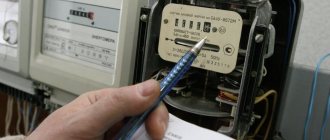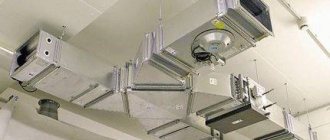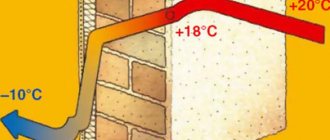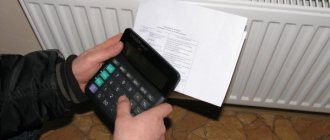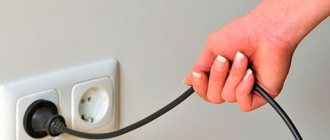When faced with the need to pay bills for the first time, many people are initially confused.
Difficulties can be caused by: installing a new meter, switching to a two-tariff meter, or even setting up an autonomous power supply system, for which you need to independently calculate the approximate power consumption without a meter.
Let's find out how to calculate the payment for electricity using the meter in all of the above cases. Everything is much simpler than it seems!
How to take meter readings correctly?
Counters come in two designs:
- Induction devices are “old-fashioned” bulky devices with a rotating wheel.
- Static - or modern electric.
Many people still have induction ones, but the trend towards switching to electronic models is already clearly visible - they calculate more accurately, look better, and do not make noise.
When taking readings from an induction device, pay attention to the first 5 digits (some models have 4).
The last digit is usually placed slightly separately or highlighted in a different color, it rotates relatively quickly - it is usually not written on the receipt (for an even and simpler counting) - this is the reading after the “decimal point” in the decimal fraction.
It is better to take data on the same day of the month. In some regions of the country, it is customary to call the MES or RES on your own (on the appointed day) and report your readings. Otherwise, the organization makes calculations based on average consumption over the past months - this data will be reflected in the receipt.
How to take readings from an electronic meter, multi-tariff readings
The electronic device can calculate a single tariff, or can be configured to count for several tariffs (different tariffs are introduced for the purpose of saving - during the day they are a little more expensive than usual, and at night they are much cheaper).
The desired mode is selected in the device menu (modes are usually changed by repeatedly pressing the enter button):
- T1 – for single tariff.
- T2 – for separate payment of the grace period from 23:00 to 7:00 am.
- T3 – one standard tariff and two preferential ones.
When these modes (T1 and T2) are displayed alternately, the device will show different readings that have accumulated over the month at a given tariff.
The difference with previous readings is calculated for each tariff separately.
How to take readings from an electric meter when replacing it
Meters are replaced due to their obsolescence, when inaccurate readings are suspected, and for periodic testing in the laboratory. What to do with the readings if the old meter was dismantled and a new one was installed?
Before the old meter is removed, the readings from it are copied onto paper.
You will need to pay off the outstanding balance on the meter.
All other manipulations will be done by the controller.
He will seal the new meter, draw up documents for it and transfer them to the service organization.
Next time the receipt will come with a new number and readings of the installed meter.
By the way, many people are interested in whether it is possible to replace the electric meter yourself? Yes, it is possible, but you must first notify the RES (you can do it by phone). But the company controller must seal the meter.
Where to transfer data
Taking data on electrical energy consumption is not enough. According to current legislation, consumers are required to transfer them to the energy sales service at their place of residence. Employees of this service regularly check the correctness of data transfer by going door-to-door and reading information from meters.
If the consumer has not provided meter readings on the due date, payment for consumption is calculated in accordance with the data for the previous reporting period. If the energy sales service does not receive data within six months, energy consumption is calculated in accordance with standard indicators.
Today, a whole system for transmitting information from meters has been developed; each consumer can choose the most comfortable method for themselves. The following options are provided:
- transfer of data on paper. It is necessary to take readings from the meter, visit the nearest energy sales service center, fill out a form for current data;
- through the Internet. To do this, you need to register on the official portal of the energy sales service and transfer information through your personal account without leaving your home or office;
- call the energy sales service contact center. To do this, it is advisable to use a mobile device or a stationary device with tone dialing mode. It is important to take meter readings first and follow the instructions dictated by the answering machine.
- automatic data transfer. To do this, you need to install an electric meter with one of the interfaces: RS485, M-Bus, PLC, GSM/GPRS, optical port, pulse output; or having a built-in radio module with Pulsar IoT or LoRa data transmission technology. In this case, no action is required from the tenant to transmit the readings; it is enough just to pay the electricity bills on time. This method is the most convenient for both the energy supply company and residents.
Calculation of power consumption
Sometimes an owner needs to know the approximate energy consumption in his home without a meter in order, for example, to switch the house to an alternative energy source.
To do this, all household appliances and light bulbs in the house are rewritten.
The power of each of them is indicated (if it is not visible on the case, it is taken from the technical documents).
Those devices that do not give off heat while they are working are called condenser devices. For them, you need to take into account that the starting power will be 2 - 2.5 times greater than that indicated in the documents.
Add up all the powers of induction appliances (giving off heat - irons, incandescent lamps, stoves, etc.) and condenser appliances (TV, washing machine, refrigerator, etc.), multiplied by 2 - 2.5.
Add 10% to stock. The required power is obtained.
You may also like
Three-phase electricity meter “Pulsar 3/T3” RS485 without button
Designed for measuring and metering active or reactive electrical energy in single or multi-tariff mode. The meter can be used autonomously or as part of automated systems for monitoring and accounting of electricity (ASKUE).
Interverification interval - 16 years; Average service life - 32 years; Average time between failures - 318,160 hours; The service life of the meter from one lithium battery is at least 16 years.
from 6328₽
Buy in bulk
Electric meter “Pulsar 1T” LCD RS485 optoport without button
Designed to account for active and reactive energy in 2-wire AC power frequency circuits. The meter can be used autonomously or as part of automated systems for monitoring and accounting of electricity (ASKUE).
Produced in accordance with GOST 31818.11-2012, GOST 31819.21-2012, GOST 31819.23-2012
Number in the state register of measuring instruments of the Russian Federation: 76979-19
Interverification interval - 16 years; Average service life - 32 years; Average time between failures - 318,160 hours; The service life of the meter from one lithium battery is at least 16 years.
from 5482₽
Buy in bulk
Electric meter “Pulsar 1T” LCD LoRa optoport without button
Designed to account for active and reactive energy in 2-wire AC power frequency circuits. The meter can be used autonomously or as part of automated systems for monitoring and accounting of electricity (ASKUE).
Produced in accordance with GOST 31818.11-2012, GOST 31819.21-2012, GOST 31819.23-2012
Number in the state register of measuring instruments of the Russian Federation: 76979-19
Interverification interval - 16 years; Average service life - 32 years; Average time between failures - 318,160 hours; The service life of the meter from one lithium battery is at least 16 years.
from 2947₽
Buy in bulk
How to calculate the cost of electricity and its consumption?
Let's look at how to calculate electricity consumption. On meters, the basic unit of measurement is 1 kW/h (kilowatt per hour). Each region has its own prices for this kilowatt.
To calculate the payment , you need to know two indicators: the tariff (how much 1 kW/h costs) and energy consumption (how much “runs up” on your meter).
There are three ways to find out local rates:
- From the receipt that comes to your apartment or house every month.
- By calling the supplier organization.
- On the official website of the relevant electrical networks.
Electricity consumption is calculated by simply subtracting the previous month's figure from the current figure.
By multiplying the expense by the tariff, we get the amount that needs to be paid for light.
Did you know that a custom heating meter can save you up to 60% on your space heating bills? Heating meter for an apartment - operating principle, installation, reading.
We'll tell you how to heat a country house with electricity here.
Installing electrical wiring requires certain knowledge. The next topic will be devoted to the intricacies of installing electricity in a private home.
Common house meter (ODN)
Another question - how to calculate one-time electricity consumption? The general meter keeps track of electricity for lighting the elevator, entrance and stairs and other joint expenses.
The payment from each owner will be greater, the more m2 of living space he occupies.
In order:
- Readings are taken in the same way as on a home device.
- The last paid data for the last month is subtracted.
- The resulting readings are divided by the area of all apartments.
- What happens is multiplied by the number of m2 of your apartment.
- Your expense is multiplied by the local rate.
How is payment calculated if there is no meter?
How to calculate electricity without a meter? There may not be an individual metering device. In this case, the average consumption rate for the region is taken.
The number of people living in the apartment is multiplied by the average consumption rate (each region has its own) and multiplied by the local tariff.
Reading data from an electronic device
An electronic meter differs from an electromechanical one not only in its operating principle, but also in the features of reading readings. Instead of a drum, the electronic meter has a digital display. The screen displays not only energy consumption readings, but also date, time, parameters of the physical quantities of the network - frequency, current, power and others.
The electronic meter has other advantages:
- the ability to set the script for displaying readings yourself;
- the presence of an integrated memory in which readings for previous periods are stored;
- possibility of remote transmission of readings;
- possibility of integration into a unified system for recording and monitoring energy consumption data.
To take readings from such a device, you need to rewrite the numbers to the decimal point - this is the number of kilowatt-hours consumed. The number on the meter after the decimal point shows 1/10 watt*h. It is not taken into account or rounded up. Flow calculation is performed in the same way as when reading readings from an electromechanical device. Data is taken at the end of the reporting period, and the readings obtained at the end of the previous reporting period are subtracted from them.
Calculation example
For example, let’s take a conventional apartment equipped with an individual meter. The owner just took a reading: 56100 kW.
Last month it recorded 55830 kW.
To find out the amount of energy expended, he subtracts the smaller from the larger:
56100 – 55830 = 270 kW.
In his area the tariff is 3.5 rubles.
270 x 3.5 = 945 rub.
That's how much he has to pay for the month.
In conclusion, we would like to add that there are many ways to pay for electricity. You can fill out the received receipt, go to the nearest bank, or even do it without leaving your home, on the website of the relevant organization. Also, many banks provide services for paying for electricity via the Internet.
Many apartment owners do not agree to pay for heating according to average rates. A heat meter for an apartment will allow you to pay for the heat actually spent.
Instructions for making an electrolyzer with your own hands are presented in this topic.
Payment Methods
Today, the population is provided with several main options for paying for consumed electricity:
- Bank branches and self-service devices. You need to transfer money using a payment document or through a special section of the terminal.
- Personal account, payment services, mobile applications. To do this you will need access to the Internet.
- Post offices or payment centers.
- Directly to the utility service provider through branch cash desks.
Regardless of the chosen method, you must receive confirmation of the completed payment.
Source
How is energy measured?
Translated from Greek, energy means activity, force, action. It is a scalar quantity and measures all kinds of motion and interconnections of matter. Energy is denoted by the letter E. The units of measurement for this quantity are: in the SI system - joule (J), in the GHS system - erg.
Electrical energy consumed by electrical appliances is calculated by meters. They provide numerical readings of power consumption (kW) per kWh.
The Relationship Between Strength and Energy
A connection has been established between the conservative force, which causes the potential energy of all interacting bodies, and this energy.
For your information. Conservative forces are those forces that do work to move a point. In this case, the work is determined by the extreme positions of this point: initial and final.
Conservative forces include the following forces:
- heaviness;
- elasticity;
- Coulomb forces.
If you close the trajectory of a point under the action of conservative forces, it will be equal to zero.
You can trace the connection using the following algorithm:
- When at any point in space a body is subject to the action of a conservative force, it means that it is located in a potential field.
- A change in the position of a body within a field causes a change in potential energy, in which a conservative force does work.
This work can be expressed mathematically. For example, the body moved in a random direction r, deviating from the initial position by a very small distance dr. This means that dA = F*dr*cosα = Fr, dr, where F = F* cosα is the projection of the force onto the direction r.
There is an equality: dA = – dEп, where Ep is potential energy. So, putting an equal sign between the two expressions, it turns out:
Fr *dr = – dEп, from which Fr = – dEп/dr is expressed.
The ratio dEп/dr is a quantity showing the rate of change of potential energy along a given direction; it is the derivative of Ep in the r direction.
Attention! The minus sign means a decrease in potential energy in the direction dr. The partial derivative symbol indicates that the differentiation of the potential energy Ep (x, y, z) occurs only with the argument x, with the other two unchanged.
Power and energy
Power P is the work done per unit of time. The unit of power is watt (W). To find out how many watts are 1 kW, you need to remember that “kilo” is 103. Therefore, 1 kW = 103 W, and 10 kW = 104 W.
Typically, the power of electrical receivers is measured in kilowatts. Applicable to technology, there is also a measurement of power in horsepower (hp). One such horsepower is equal to 736 watts.
Power and horsepower
The ability of a certain body or an entire system to perform work is characterized by its energy. Energy unites in its concept all events in nature. Different types of movement are characterized by different types of energy.
Advice. Mechanical energy related to the movement of a body is called kinetic, associated with the mutual position of bodies (body parts) of the system - potential.
Calories and joules
Before you figure out how to convert (convert) calories to joules and vice versa, you need to know what these two concepts mean.
The joule is a unit used to measure work, energy, or heat. In the international SI system, the joule is denoted by J (J). The work done by a force of one newton (1N) to move a point in the direction of application of the force one meter (1m) is equal to one joule (1 J).
Calorie is a quantity not separately reflected in measurement systems, used to determine the amount of heat. To heat 1 g of water by 1 C0, you need to spend energy equal to 1 calorie (cal). In this case, 1 cal = 4.1868 J.
Communication with other units
You can use an online calculator to express calories in joules and back.
The program interface allows you to enter the values of the required quantities (using abbreviations of multiple values). When you don’t have the Internet at hand, it’s easy to make a translation by making a proportion. For example, you need to find out how many kilocalories are in 100 kJ. To do this, make up the proportion:
- 1 kcal = 4.1868 kJ;
- X = 100 kJ.
Solving the proportion, we get the expression X = 100 * 1/4.1868 = 23.9 kCal. The answer is that 100 kJ contains 23.9 kcal.
A little about electricity tariffs
There are several ways to find out how much you pay for electricity:
- look at the receipt for payment received;
- contact the control room;
- look on the supplier's website.
Typically, each region has its own payment tariff, which is set by the Federal Tariff Service.
They differ according to consumer groups as follows:
- Industrial group: payment is made according to the contract, regardless of actual expenses.
- Conditionally industrial: this includes public transport and agriculture. They pay for certain capacities, but use a meter.
- Budgetary: these are schools, hospitals and government agencies. Their costs are reimbursed from the budget, but different tariffs are used for calculation.
- The population or all citizens.
Time is considered night time from 23:00 to 7:00 the next day. Electronic meters even have different windows to indicate these values, making it easier to read the data.
Please note: Some regions have social limits on electricity consumption. It has low tariffs, but if the limit is exceeded, the consumer pays a different tariff and significantly more.


